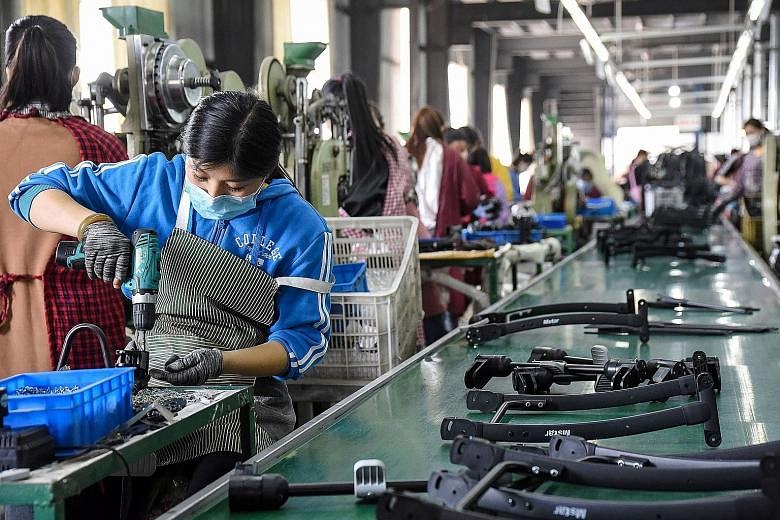BEIJING • China's factories suffered a collapse in export orders in April, twin surveys showed yesterday, suggesting a full-blown recovery appeared some way off as the coronavirus health crisis shut down large parts of the world economy.
The sobering result comes amid moves by major nations to ease up on lockdowns, underlining the stiff challenges facing businesses as policymakers prepare for the worst slump since the Great Depression.
China's official Purchasing Managers' Index (PMI) eased to 50.8 in April from 52 in March, the National Bureau of Statistics (NBS) said, but stayed above the neutral 50-point mark that separates growth from contraction on a monthly basis.
Analysts polled by Reuters had expected a PMI reading of 51.
Worryingly, a sub-index of export orders for the world's biggest exporter dived to 33.5 in April from 46.4 in March with some factories even having their orders cancelled after reopening, said senior statistician Zhao Qinghe at the NBS.
Export orders in the private Caixin/Markit Manufacturing PMI survey contracted at the fastest pace since the global financial crisis. The poll, which focuses mostly on small and export-oriented firms, showed activity for Chinese factories unexpectedly shrank last month.
"It is still too early to conclude that the Chinese economy is growing again," said ING's Greater China chief economist Iris Pang.
"The Western world has yet to relax some of its city lockdowns. And even after the lockdowns are relaxed, it is uncertain when demand will return to pre-Covid-19 levels due to strict social distancing measures implemented domestically and in foreign economies."
With Covid-19 largely under control domestically, China's economy has begun to open up again as officials loosen lockdown restrictions.
But major economies, including the United States and Europe, remain in the grip of the pandemic amid mounting infections and deaths. Analysts warn that the rest of the year will be bumpy for businesses and consumers in China, especially due to depressed external demand and mounting job losses.
"The market's optimism of a quick recovery in China is fading," Nomura analysts said in a note. "We expect export growth to slump further to -30 per cent in Q2 from -13.3 per cent y-o-y (year-on-year) in Q1 and real GDP growth to remain negative at -0.5 per cent y-o-y in Q2."
China's economy took a heavy blow in the first quarter, shrinking an annual 6.8 per cent, the first contraction since current quarterly records began almost 30 years ago.
"The poll shows as many as 57.7 per cent of the factories surveyed have reported a lack of orders. Some have said market demand is tepid, product sales are difficult and it will take time for orders to come back again," the NBS said. That led to a slower expansion in production over April. Labour conditions improved for the second straight month, but the pace of employment slowed to 50.2 from 50.9 in March.
A private survey by China Beige Book International (CBB) showed on Wednesday that by late April, 91 per cent of Chinese companies had reopened, but over two-fifths of them were unable to operate at more than 50 per cent capacity, suggesting many firms are struggling to resume normal operations.
"The official story tends to highlight the recovery of the most high-profile areas of China's economy, such as large SOEs (state-owned enterprises). But our deeper look at the crucial private sector, especially SMEs, shows critical metrics such as output, sales volumes and hiring sliding even over a weak March," said Mr Leland Miller, chief executive of CBB.
A factory owner surnamed He told Reuters her textile company in Shaoxing, Zhejiang, which supplies a Los Angeles-based women's clothes label, had her US client cancel up to 190,000 yuan (S$38,000) in orders last month.
"There have been a lot of factories that went under recently. Many factories around me - they serve foreign orders - are closed," said Ms He, adding that her factory was able to avoid that fate because it still has domestic business.
"The impact (from the coronavirus outbreak) is huge."
Not surprisingly, the pandemic has taken a toll on jobs. China's urban jobless rate fell to 5.9 per cent in March from February's record high of 6.2 per cent, suggesting the pain in the labour market is yet to be reflected in official numbers.
The service sector, which accounts for 60 per cent of gross domestic product, also saw an expansion in activity, with the official non-manufacturing PMI rising to 53.2 from 52.3 in March, a separate NBS survey showed.
REUTERS











